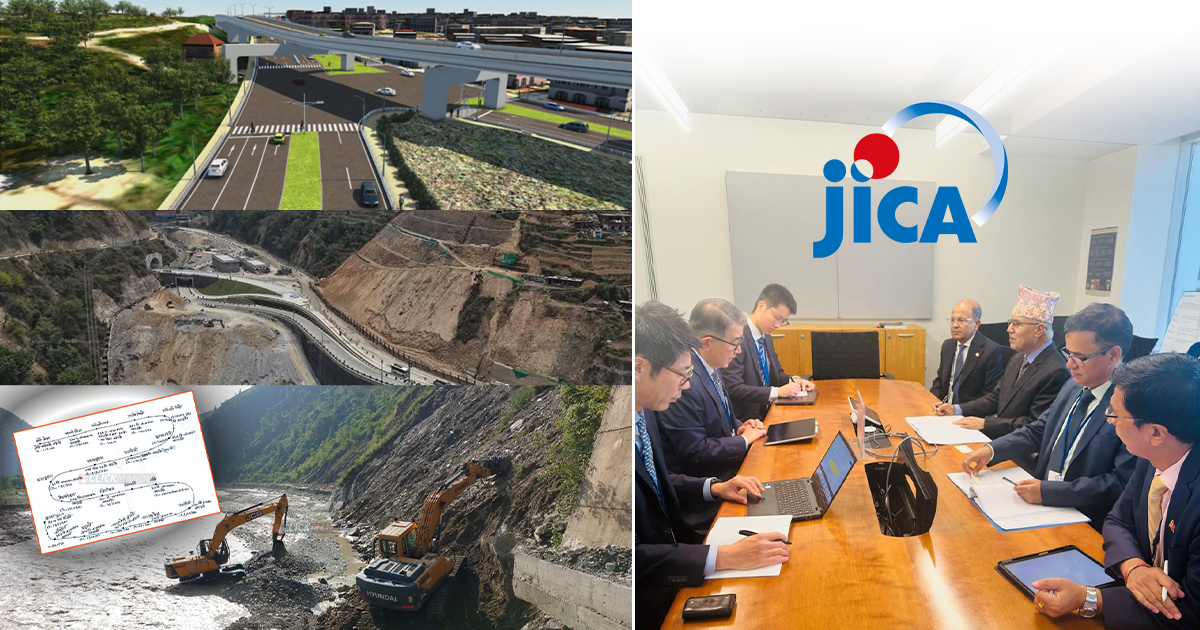Kathmandu: Finance Minister Rameshore Khanal has held talks with officials from the Japan International Cooperation Agency (JICA) to push forward the construction of three major road projects in Nepal.
Currently on an official visit to the United States, Minister Khanal discussed the restoration of the BP Highway, the completion of the Nagdhunga Tunnel, and the construction of the Koteshwar underpass section during a meeting with JICA representatives.
According to the Ministry of Finance, Khanal met JICA officials in Washington, DC, on the sidelines of the World Bank and International Monetary Fund’s annual meetings. He urged Japan to increase investment in Nepal’s infrastructure and human development sectors.
The BP Highway—built with Japanese assistance—has suffered severe damage from floods over the past two years. Khanal requested JICA’s support to expedite its restoration, as well as to complete the Nagdhunga Tunnel, which serves as the main entry point to Kathmandu.
He also pressed JICA to fast-track the planned Koteshwar underpass section, a project to be built with 30 billion rupees in Japanese soft loans.
The Koteshwar underpass is scheduled for completion by 2090 BS (mid-September 2033). Although the loan agreement for the 30-billion-rupee project was expected to be signed in September, it has yet to be finalized, according to the Department of Roads.
The department said the Detailed Project Report (DPR) and Environmental Impact Assessment (EIA) will be completed by the end of March next year. Construction contracts are expected to be awarded by April 2028, with the work slated for completion within 52 months.
A tunnel and flyover will be built from Tripureshwor’s Tinkune area to Manohara, within the Tribhuvan International Airport zone. JICA has already completed the preliminary survey.
JICA had earlier conducted a pre-feasibility study for the project in 2019, which estimated the cost at approximately 34 billion Nepali rupees. The study presented three technical alternatives for the government’s consideration. In January 2024, JICA submitted an updated preliminary report with refined recommendations.
Meanwhile, reconstruction of a severely damaged section of the BP Highway—destroyed by landslides and floods in recent monsoons—is in its final approval phase. About 28 kilometres of the highway were completely destroyed.
Of the five affected sections, contracts have been awarded for three, while one is under bidding. The remaining section will be rebuilt with JICA’s grant assistance.
According to the Department of Roads, contracts have already been signed for the Charause–Bhakundebesi, Dalabesi–Charause, and Nepalthok–Barkhekhola sections. Around 5.5 kilometres of road remain without a contractor.
Due to the difficult terrain and high cost, the government divided the remaining 5.5-kilometre Barkhekhola–Dalabesi stretch into two segments: Barkhekhola–Piple (3.2 km) and Piple–Dalabesi (2.3 km). The latter has already been tendered under government funding, pending contract signing.
JICA will undertake the construction of the 3.2-kilometer Barkhekhola–Piple segment, providing a grant of 2.8 billion Japanese yen (approximately 2.59 billion rupees).
Separately, Nepal began constructing the Nagdhunga Tunnel in 2016 with a 16.8 billion-rupee loan from Japan. The project’s total cost is estimated at 22 billion rupees.
The project, contracted to Japan’s Hazama Ando Corporation, is nearing completion. After final operational preparations, the tunnel is expected to open to traffic by mid-December.



Comment Here